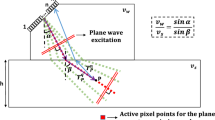Abstract
Along with such advantages as high resolution over the entire area of reflector image reconstruction and the ability to produce images taking into account the reflection from and transformation of wave type at the boundaries of a test object, reconstruction of reflector images by the digital antenna focusing (DFA) method has several disadvantages, including a large volume of measured echo signals, long image reconstruction time, and an insufficiently high energy of ultrasonic waves introduced into the test object. Plane wave imaging (PWI) combines the benefits of phased antenna array (PAA) and DFA technologies. In the PWI mode, all elements of the antenna array (AA) operate when a plane wave is emitted (as in the PAA mode), which makes it possible to increase the energy introduced into the test object, and echo signals are recorded by all elements of the AA (as in the DFA mode). Reflector images are reconstructed by the SAFT method. To produce an image, one can use the number of emitted plane waves less than the number of elements in the antenna array, thus decreasing the volume of measured echoes. Transferring calculations into the domain of spatial sectors allows improving the performance of reconstructing the images of reflectors. Model experiments have shown the positive and negative aspects of producing the images of reflectors by the PWI method compared to the DFA technique both with and without a wedge.
















Similar content being viewed by others
REFERENCES
Advances in Phased Array Ultrasonic Technology Applications, Waltham: Olympus NDT, 2007. https://www. olympus-ims.com/en/resources/books/. Accessed November 26, 2020.
Voronkov, V.A., Voronkov, I.V., Kozlov, V.N., Samokrutov, A.A., and Shevaldykin, V.G., On the applicability of antenna array technology in ultrasonic testing of hazardous production facilities, V Mire NK, 2011, no. 1, pp. 64–70.
Bazulin, E.G., Comparison of systems for ultrasonic nondestructive testing using antenna arrays or phased antenna arrays, Russ. J. Nondestr. Test., 2013, vol. 49, no. 7, pp. 404–423.
Hunter, A.J., Drinkwater, B.W., and Wilcox, P.D., The wavenumber algorithm for full-matrix imaging using and ultrasonic array, NDT Int., 2006, vol. 39, no. 7, pp. 525–541.
Parfenov, V.I. and Golovanov, D.Yu., Detection of discrete sparse signals with a sampling frequency not exceeding the Nyquist frequency, J. Radio Electron., 2017, no. 6. http://jre.cplire.ru/jre/jun17/1/text.pdf. Accessed December 9, 2018.
Avagyan, V.K. and Bazulin, E.G., Increasing the rate of recording echo signals with an ultrasonic antenna array using code division multiple access technology, Russ. J. Nondestr. Test., 2020, vol. 56, no. 11, pp. 873–886.
Montaldo, G., Tanter, M., Bercoff, J., Benech, N., and Fink, M., Coherent planewave compounding for very high frame rate ultrasonography and transient elastography, IEEE Trans. Ultrason. Eng., 2009, vol. 56, pp. 489–506. https://doi.org/10.1109/TUFFC.2009.1067
Jeune, L., Imagerie ultrasonore par emission d’ondes planes pour le contrôle de structures complexes en immersion, Pour l’obtention du grade de Docteur de l’université Paris-Diderot, Paris, 2016.
Merabet, L., Robert, S., and Prada, C., Comparative study of 2D ultrasound imaging methods in the f-k domain and evaluation of their performances in a realistic NDT configuration, IEEE Trans. Ultrason. Eng., 2019, vol. 66, no. 4, pp. 772–788. https://doi.org/10.1063/1.5031654
Dolmatov, D.O., Sednev, D.A., Bulavinov, A.N. et al. Applying the Algorithm of Calculation in the Frequency Domain to Ultrasonic Tomography of Layered Inhomogeneous Media Using Matrix Antenna Arrays, Russ. J. Nondestr. Test., 2019, vol. 55, no. 7, pp. 499–506.
Kovalev, A.V., Kozlov, V.N., Samokrutov, A.A., Shevaldykin, V.G., and Yakovlev, N.N., Pulse echo method for testing concrete. Interference and spatial selection, Defektoskopiya, 1990, no. 2, pp. 29–41.
Taki, H., Taki, K., Sakamoto, T., Yamakawa, M., Shiina, T., Kudo, M., and Sato, T., High range resolution ultrasonographic vascular imaging using frequency domain interferometry with the Capon method, IEEE Trans. Med. Imaging., 2012, vol. 31, no. 2, pp. 417–429.
Born, M. and Wolf, E., Principles of Optics, Cambridge: Cambridge Univ. Press, 1999.
Bazulin, E.G., Allowing for inhomogeneous anisotropy of a welded joint when reconstructing reflector images from echo signals received by an ultrasonic antenna array, Russ. J. Nondestr. Test., 2017, vol. 53, no. 1, pp. 9–22.
NVIDIA CUDA ™ technology. https://www.nvidia.com/ru-ru/technologies/cuda-x/. Accessed November 21, 2020.
Ugryumov, E.P., Programmable logic matrices, programmable matrix logic, basic matrix crystals, in Tsifrovaya skhemotekhnika. Uchebnoe posobie dlya VUZov (Digital Circuitry. A University Handbook), St. Petersburg: BHV-Petersburg, 2004, 2nd ed.
Bazulin, E.G., Testing of weld patches in Дy800 pipelines with ultrasonic antenna arrays using the triple scanning method, Russ. J. Nondestr. Test., 2010, vol. 46, no. 7, pp. 498–506.
Goryunov, A.A. and Saskovets, A.V., Obratnye zadachi rasseyaniya v akustike (Inverse Problems of Scattering in Acoustics), Moscow: Mosk. Gos. Univ., 1989.
Bazulin, E.G., Utilization of double scanning in ultrasonic testing to improve the quality of the scatterer images, Acoust. Phys., 2001, vol. 47, no. 6, pp. 649–653.
Kokolev, S.A., Bazulin, E.G., and Bazulin, A.E., Application of linear interpolation for improving the quality of flaw images obtained by the spectral projection method during ultrasonic nondestructive testing, Russ. J. Nondestr. Test., 2009, vol. 45, no. 12, pp. 823–837.
Official site of ECHO+ company. URL: http://www.echoplus.ru. Accessed November 21, 2020.
Author information
Authors and Affiliations
Corresponding author
Rights and permissions
About this article
Cite this article
Bazulin, E.G., Evseev, I.V. Applying Plane Wave Imaging Technology in Ultrasonic Nondestructive Testing. Russ J Nondestruct Test 57, 423–436 (2021). https://doi.org/10.1134/S1061830921060048
Received:
Revised:
Accepted:
Published:
Issue Date:
DOI: https://doi.org/10.1134/S1061830921060048




